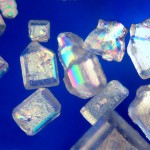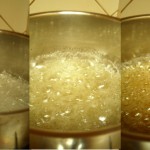From a culinary perspective, sugar is a very important ingredient so understanding how it reacts while being heated, melted, dissolved, etc is very crucial. One of the most integral parts of this is an understanding of what happens in a simple sugar and water solution. In this case, the sugar molecules have a tendency to bond to each other in orderly arrays and form dense solid masses (crystals). When sugar crystals are dissolved in water, H2O molecules have a tendency to overcome this bond between sugar molecules and form their own bonds. If the sugar molecules become too crowded with the water molecules, they begin pairing off with each other and form crystals once again.
One way to change the amount of sugar and water bonds in a simple syrup (sugar + water) is through an increase (or decrease) in temperature. As a sugar solution boils, water molecules evaporate from the liquid while the sugar molecules remain behind changing the concentration of the syrup (also its boiling point) and the amount of bonds present. Such a phenomenon is very important in the making of candies, meringues and various other desserts.
Remember, as you cook your sugar syrup, most of the heat goes into the work of evaporating the water molecules and less into actually rising the temperature of the liquid as a whole, so the temperature reading will rise only gradually. However, as the sugar concentration passes 80%, there’s very little water left to evaporate so the temperature of the syrup will begin rising very rapidly. A candy (or digital) thermometer as crucial when making any recipes including a sugar syrup.
A cold water test is another way of getting a syrup behaviour reading without the use of a thermometer. This test requires a small sample of the syrup to be cooled quickly (dropped in cold water) and then noting its behaviour. Thin syrups simply form a thread in the air, more concentrated solutions form a malleable ball while others make very hard brittle threads.
Here’s a general list of temperatures, the cold water test result and what confections they’re predominantly used for:
102-113C – malleable threads – used in syrups and preserves
113-116C – soft ball stage – used in fondants and fudge
118-121C – firm ball stage -used for caramels
121-130C – hard ball stage – used in marshmallows and nougat
132-143C- soft crack stage (very brittle) – used for taffy
149-154C – hard crack stage – used in butterscotch and brittle
160-168C – beginning to turn colour, cold water test no longer applies – used in hard candies and toffee
180-182C – has a deep golden brown colour – used in spun sugar, medium caramel
188-190C – a reddish brown colour – used for dark caramel

